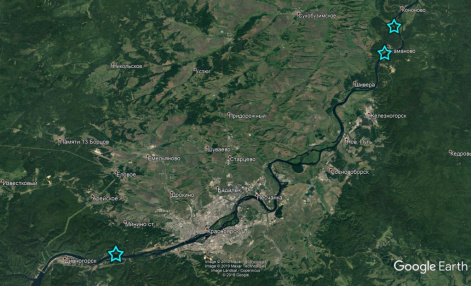Krasnoyarsk scientists: the amount of radioactive isotopes in biota of the Yenisei river decreases
6 September 2019 г.

Certain technological processes involved in the production of nuclear power lead to artificial radioactive isotopes entering water bodies. Radionuclides can accumulate in living beings, posing a threat to inhabitants of water bodies, as well as they can be transported through fish into the human organism. Radionuclides were introduced to the Yenisei because of the operation of nuclear reactors located near the town Zheleznogorsk. To cool the reactors, the water was supplied from the reservoir, to be discharged after the cycle into the river. In 2010, the last reactor was shut down and the amount of discharges reduced. In this regard, the question arose whether there was a decrease in the number of radionuclides in plants and animals living in the Yenisei River near radioactive discharges.
Scientists at the Institute of Biophysics of the Krasnoyarsk Science Center SB RAS found out that shortly after the shutdown of the last reactor, radioactive isotopes with a short half-life (sodium, scandium, chromium, manganese, cobalt, iron, zinc, ruthenium, cerium, europium, neptunium) almost completely disappeared from biota samples. For the isotopes cobalt-60, zinc-65, and europium-152, it was possible to estimate the rate of decrease in their content in the biomass of living creatures of the Yenisei.
Until now, the long-lived isotope of cesium (cesium-137) has been detected in the organisms of the inhabitants of the Yenisei, but its content in the muscles of commercial fish is much lower than the allowed standards. Based on the dynamics of discharging this radioactive isotope, the researchers say that it is possible that in a few years the content of radiocesium in biota will also decrease.
The possibility of increased accumulation of radionuclides in predatory fish from food was also evaluated. The results show that the concentration of cesium in the pike is several times higher than in the fish consumed by the pike.
In their study, scientists measured the concentration of radionuclides in different types of living organisms inhabiting the Yenisei near the site of radioactive discharges. For analysis, samples of mass species of fish (pike, grayling, dace), animals living on the river bottom (amphibian crustaceans and caddis larvae) and aquatic moss had been taken during several years before and after the shutdown of the MCC reactor. The area located upstream the river was used as the background site. Data on the annual discharges of radionuclides into the river ecosystem were obtained from publicly available reports of Roshydromet.
“Contamination of the Yenisei with technogenic radionuclides is a reality which we cannot change, but we have an opportunity to study this unique phenomenon and to obtain new information on the behavior of radionuclides in a large flowing freshwater ecosystem, and their interaction with biota. Studying the radioactive contamination of the Yenisei, we obtained new data which are interesting not only for us, but also for the international scientific community,” - says co-author of the article, Tatyana Zotina, Candidate of Biological Sciences, senior research associate at the Institute of Biophysics, Krasnoyarsk Science Center SB RAS.
The study was supported by the Russian Foundation for Basic Research and the Krasnoyarsk Regional Science Foundation
Share:
